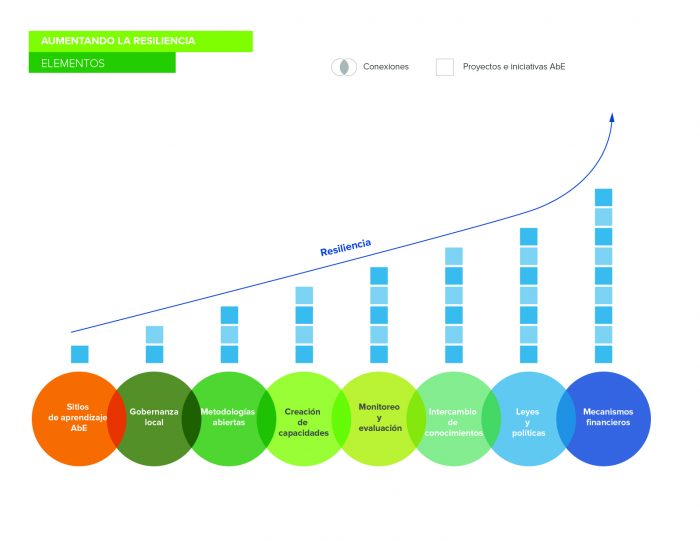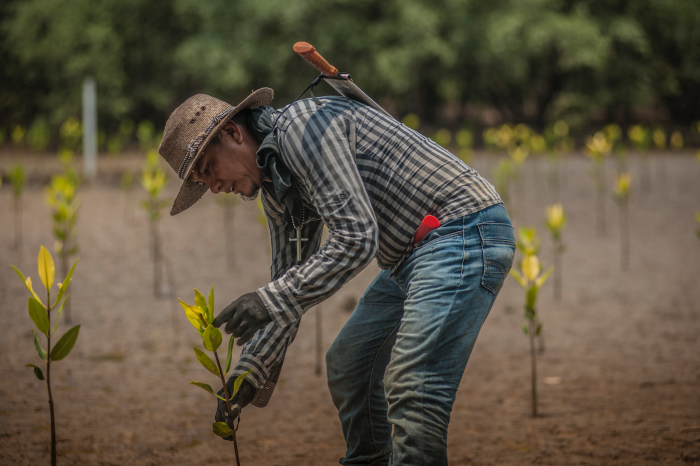The evidence obtained by Project AVE (Adaptation, Vulnerability and Ecosystems) of the International Union for Conservation of Nature (IUCN) about Ecosystem-based Adaptation (EbA) measures in six transboundary watersheds of Mexico and Central America supports a governance approach for climate change adaptation. The results indicate that the measures implemented in Chiapas are an example to follow.
Learning from local experience is essential for the selection of climate change adaptation measures. Nature also plays a crucial role in this process, and strong governance structures are the key vehicle for local implementation of EbA. But how can these proposals and solutions be brought to other communities, social sectors and levels? Through Project AVE, the Regional Office for Mexico, Central America and the Caribbean (ORMACC) and the IUCN’s Environmental Law Centre work in six EbA learning sites in transboundary watersheds of Mesoamerica to scale and build the evidence base about the benefits of the EBA approach. The elements that will be scaled are presented in the following graph:

Chiapas, one of the states with the greatest vulnerability to climate change in Mexico, has pursued ambitious efforts to combat climate change. Several EbA measures have been implemented in communities located in the upper part of the Cahoacan River Basin and on the coast—areas connecting to the Coatan River—including reforestation with forest and fruit species, soil conservation efforts, recovery of degraded forests and mangrove restoration.

Due to successful local-level adaptation, EbA measures have been scaled up in the Azteca ejido through the Local Strategy for Sustainable Development under Climate Change. The strategy is being integrated into the policies and practices of governments, companies and communities to improve ecosystem services and reduce vulnerability to climate change.
Given the fundamental role of dialogue for effective governance and the scaling up of adaptation processes, the Natural Solutions and Governance for Climate Change Adaptation Forum was organized in Tapachula to promote the exchange of ideas among key decision-makers. In addition, the Advisory Council on Climate Change of the State of Chiapas was recently reinstated, another key space for dialogue that responds to the Inter-Secretariat Coordination Commission on Climate Change.

Project AVE is implemented in five other Central American countries. In this way, the regional experience enriches the national and local work of each learning site (see map).
GUATEMALA
· The IUCN works closely with community organizations and Guatemala’s Ministry of Environment and Natural Resources (MARN) to scale the learning of EbA measures across the Guatemalan highlands.
HONDURAS AND EL SALVADOR
· Together with the Trinational Commission for the Trifinio Plan, actors from the binational sub-basin of the Sumpul River have learned about the multiple benefits of EbA to combat the climate change impacts on their crops. Similar work is being done in the communities of Honduras’ and El Salvador’s Goascoran River Basin; and in the coastal areas of El Salvador’s Paz River.
COSTA RICA AND PANAMA
·Work is being completed to improve the food security of the indigenous groups and local communitiesindigenous groups and local communities of the Binational Sixaola River Basin. Recently, the Fifth Agrobiodiversity Fair was held in Sixaola, Costa Rica. It included participation from more than 100 stakeholders, including producers, municipal authorities, indigenous representatives, academics, state institutions and non-governmental organizations.
· Costa Rica and Panama hosted an event to reforest the Sixaola River Basin in which children, youth and adults planted more than 3,000 trees to help deter the harmful impacts of future floods.

Project AVE’s EbA activities are financed through the International Climate Initiative (IKI) of The Federal Minister for the Environment, Nature Conservation, and Nuclear Safety (BMU).
This article belongs to the IUCN. Its content is the exclusive responsibility of the author.
